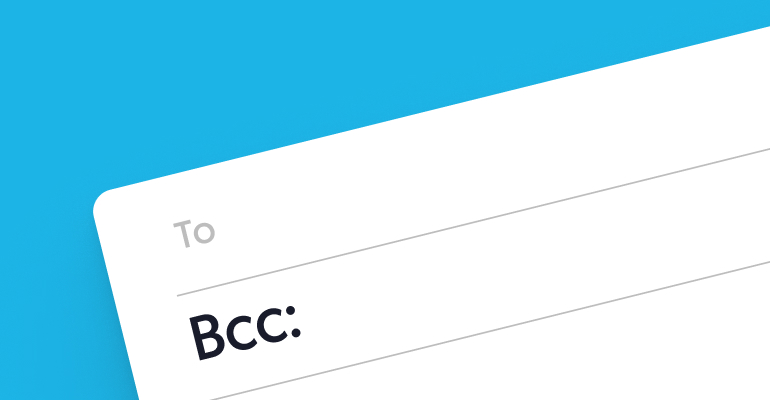How does BCC work: complete guide
Do you want to know how BCC works? Read here a complete overview and useful tips for using the Blind Carbon Copy (BCC) feature in the email!

How Does BCC Work?
Anyone who uses email on a regular basis has probably noticed that in addition to the To field, there is also a spot to fill in Cc and Bcc. While you might know that these options can be used to send a single email to multiple recipients, you might not know the exact differences between the two.
Cc stands for carbon copy, a method of copying a document in the pre-email days, but in our context is used to send an email to multiple recipients besides the main recipient in the To line. Everyone who is Cc’d on an email sees everyone else who is Cc’d. Think of it as a conference call in writing.
Bcc stands for blind carbon copy and works similar to the Cc field in that the same mail will be sent to everyone in this field, except, no one can see who is Bcc’d other than the person sending the email.
Still, confused about when and why you would use Bcc and how to use this email feature correctly? Not to worry, we have compiled a complete guide with everything you need to know!

What is Bcc?
As briefly mentioned above, Bcc stands for blind carbon copy and is an email feature that allows you to send the same email to a large number of people while keeping the list of recipients invisible to everyone but the sender himself.
In other words, if you send an email to a recipient in the To line and Bcc another person, the original recipient will have no way of knowing that someone else is included in the email chain.
This concept might seem a little sneaky, and can in fact be used incorrectly, either purposely or by accident. It is important to fully understand when and how to use Bcc in order to avoid any uncomfortable situations in which secret recipients are revealed and people feel as though they were deceived.
How does Bcc work?
To review, those who have been Bcc’d on an email will be able to read the mail that has been sent but not be able to view who else has been Bcc’d and will also be invisible to those in the To and Cc lines.
In order words, Bcc is a way to send a mass email without showing all the recipients.

When should you use Bcc?
Bcc may have some potential pitfalls, but when used correctly can be a very useful email tool for maintaining security and privacy.
For example, if you wish to send out a promotional email for your business and have a large list of recipients, you can add everyone to the Bcc field to ensure the privacy of your clients’ email addresses.
Another useful time to use Bcc is to contact multiple freelancers for a potential job offer without exposing their personal email addresses to one another.
In these cases, is important to make sure EVERYONE is added to the Bcc field to avoid any mishaps. As long as all the emails are in the Bcc field, even hitting “reply all” will not reveal any unwanted information.
How do you send a Bcc email?
Depending on your email provider, the Bcc field might already be visible when opening up a new email window. In Gmail, when you open up a new email, there will be a small Bcc button in the upper-right-hand corner. Just click the Bcc button, and a bar will appear under the To field.
Add the email addresses to the Bcc bar, and you’re ready to send.
When sending a new email in Outlook, click on “Options” and you will see the Cc and Bcc options available. Again, just add your email addresses to the Bcc bar and send away!
If you wish to remove the Bcc field, just go back into Options and click Bcc again.
Is Bcc really hidden?
You might be wondering how secure Bcc really is. Is there any way for the other recipients of the mail to find out who was Bcc’d?
The simple answer is no. No one in the To, Cc, or Bcc lines will know who was Bcc’d.
Only the sender can look in their sent folder to see the full list of who received the mail. In theory, if the sender were to be hacked, the list of those Bcc’d could be revealed but this is a worst-case scenario.
However, there are other potential mistakes that could happen when using Bcc that are important to be aware of.
Let’s say someone was Bcc’d on an email and they hit reply all. Their response will be sent to the original sender, in addition to everyone in the To and Cc fields. Assuming those Bcc’d were hidden for a reason, this can cause major trust and privacy issues for those who did not know the mail was available to additional people.
This can be detrimental to brands or small businesses hoping to build trust and ensure the privacy of those doing business with them. It begs the question, what motivation did the sender have to hide some of the recipients?
Those Bcc’d without a clear explanation can also be put in a difficult position. If there is private information included in these emails, the Bcc’d party might not know if they should discuss the content of the email unless it was explicitly stated.

Benefits of using Bcc
As mentioned above, Bcc is great for maintaining privacy and security, but it also has some other benefits.
Nothing is more annoying than being stuck on an email chain that is irrelevant to you. Maybe you were included in the original message for a reason, but all the additional responses are clogging your inbox.
The Bcc tool can be used to prevent unnecessary inbox overflow.
If you are sending out an original email that is important for many people to see, but you don’t want everyone to receive unnecessary replies or personal questions, Bcc is perfect. Those Bcc’d on an email will see the first email, but will not receive the replies of anyone else.
Bcc can also be used as anti-virus protection. Many viruses are sent through email and these spam programs find people’s email addresses by canning mail files on an infected computer. If one of your Bcc recipients gets a virus, the rest of the contacts that you Bcc’d on the email will be protected from this virus.
The difference between Cc and Bcc
Just to review, Cc and Bcc are similar but those Cc’d are visible to each other and those Bcc’d are not. You might Cc someone on an email if you want them to be in the loop on something, but they are not the main person you’re sending to.
Important tips for using Bcc when creating an email
Be cautious! As we previously discussed, mistakes when using Bcc can not only make for awkward situations but can be costly to your businesses. If a client feels their privacy is compromised by working with you, they probably won’t take the chance.
Make sure to double-check your emails before sending them. It can be easy to mix up the Cc and Bcc fields if you are being careless. If you want all of your recipients to be in the Bcc line, make sure you didn’t accidentally put them in the Cc section.
Be honest! We advise that you don’t Bcc people on emails for any secretive purposes. Maintaining integrity is part basic when it comes to good business practices and as a person in general.
You wouldn’t want to feel like you were sharing information with one person, only to find out it was privy to others without your knowledge, so treat others with the same respect.
Bcc email examples
We touched on a few examples of when to use Bcc, but let’s get a little more specific.
If you have a list of monthly subscribers to your newsletter, you don’t want to reveal their email addresses to one another. This is a perfect example of when to use Bcc. By adding all the recipients to Bcc, you will send out your newsletter and maintain your subscribers’ privacy.
Bcc is also great for sending out invitations to an event or making a company-wide announcement. You will maintain the recipients’ privacy and avoid clogging their inboxes with replies, all at once.
Really any time you wish to send a wide audience a single message, Bcc is the email tool for you.
When used incorrectly, Bcc can cause more harm than good. No one wants to feel like their personal information is at risk when subscribing to a newsletter or business that they love. But when Bcc is done right, it can be a major time-saver and privacy protector.
Now that you understand Bcc, you can fully take advantage of everything it has to offer without worrying about making mistakes along the way.


